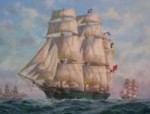 More talks to save the fine old ship from being broken up. Only time will tell whether anyone will come up with the funds to rescue her.
More talks to save the fine old ship from being broken up. Only time will tell whether anyone will come up with the funds to rescue her.
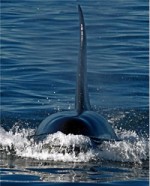 Two only slightly related items : “An orca baby boom” in Washington State following a year that saw a decline in the number of orcas in the southern resident pods, and a very funny, if highly offensive, episode of South Park, in which the kids teach the Japanese to stop slaughtering whales and dolphins and to start slaughtering cows and chickens like Americans do. Thanks to Bowsprite for passing it along.
Two only slightly related items : “An orca baby boom” in Washington State following a year that saw a decline in the number of orcas in the southern resident pods, and a very funny, if highly offensive, episode of South Park, in which the kids teach the Japanese to stop slaughtering whales and dolphins and to start slaughtering cows and chickens like Americans do. Thanks to Bowsprite for passing it along.
Tom Russell is hosting the Tall Ship & Traditional Sail Professionals Group on LinkedIn. It is a very interesting group. He writes:
If you’ve worked on a tall ship, for its supporting organization or in other traditional sail, feel free to join the group below. Simply add the traditional sail info to your profile.
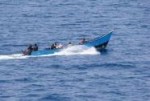 The International Chamber of Shipping (ICS) issued a statement which we think is right on target. The current policy of disrupting but not consistently apprehending pirates has been a failure.
The International Chamber of Shipping (ICS) issued a statement which we think is right on target. The current policy of disrupting but not consistently apprehending pirates has been a failure.
The unacceptable situation prevailing now, with seafarers lives being threatened on a daily basis – and Somali pirates still operating with impunity – cannot be allowed to continue.
It is particularly upsetting when the main focus of some senior politicians is limited to commenting on their objections to the payment of ransoms. But given the inability of the international community to intervene in Somalia, the shipowner currently has little alternative when confronted with seafarers being held hostage.”
Continue reading
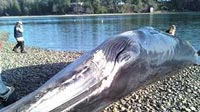 What appears to be the carcass of a Bryde’s whale has washed ashore in Case Inlet in Puget Sound in Washington State. If it is a Bryde’s whale, it is a mystery what a whale that favors tropical waters was doing in the frigid waters of the Pacific Northwest.
What appears to be the carcass of a Bryde’s whale has washed ashore in Case Inlet in Puget Sound in Washington State. If it is a Bryde’s whale, it is a mystery what a whale that favors tropical waters was doing in the frigid waters of the Pacific Northwest.
Cetaceous stranger washes up in Puget Sound
Continue reading
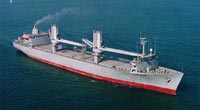
SS Cornhusker State
The US military hopes to have the port of Port-au-Prince open for shipments of emergency relief supplies in two or three days.
Damaged Haiti port to open in 2-3 days: U.S. commander
In related news, the Maritime Administration has ordered the activation of the crane ships, SS Gopher State and the SS Cornhusker State, both based in Norfolk. The SS Cape May, a SEABEE class Heavy lift/Barge Carrier, was also activated as was the OPDS SS Petersburg, an Offshore Petroleum Discharge System tanker, based in Alameda, CA and the high speed ferry M/V Huakai, based in Norfolk, VA.
UPDATE: Maran Tankers Management Inc. said the crew – 9 Greeks, 16 Filipinos, 2 Ukrainians, and a Romanian – was safe and well.
In strange turn, pirates send out an SOS
Unconfirmed reports suggest that infighting between rival pirate gangs may have disrupted payment of the ransom and the release of the ship.
Owners of a Greek-flagged oil tanker dropped a record ransom payment of $5.5 million to $7 million on the deck of the ship today, prompting Somali pirates to release the Maran Centaurus.
Ransoms to Somali pirates have reached a historic high, as owners of the Maran Centaurus – a Greek-flagged oil tanker – dropped a ransom payment of $5.5 million to $7 million on the deck of the ship today.
The payment, which prompted Somali pirates in the port of Haradheere to release the ship, marks a dramatic escalation in ransom payments since the $3 million payment for the Saudi owned oil tanker Sirius Star last year. While US and European navies continue to patrol shipping lanes off the Somali coast, there has been no letup in pirate attacks, and pirates, if anything, appear to be becoming even more effective at capturing ships.
The Australian National Maritime Museum has an exciting season of sailing coming up on the replica of the HMB Endeavour. This April, they are offering day sails in Sydney Harbor, to introduce visitors to 18th century sailing; overnight sails where the volunteer crew can sleep in hammocks, just like Cook’s crew; and five and six day voyages where the volunteers will help sail the ship while learning about navigation, meteorology and tall ship sailing.
Maritime Museum announces 2010 program for Endeavour replica
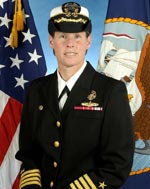 Cruiser CO relieved for ‘cruelty’
Cruiser CO relieved for ‘cruelty’
The commanding officer of the Yokosuka, Japan-based cruiser USS Cowpens was relieved of duty Wednesday after being punished for “cruelty and maltreatment” during her time in charge, the Navy announced. In an unusual move, she is being permitted to continue on to an assignment in the Pentagon.
Capt. Holly Graf was brought before an admiral’s mast with Rear Adm. Kevin Donegan, the commander of Carrier Strike Group 5, after an inspector general’s investigation found problems with her “temperament and demeanor vis-a-vis her subordinates,” said Cmdr. Jeff Davis, a spokesman for 7th Fleet.
Continue reading

While there have been locks on the Saint Lawrence River since at least 1862, the St. Lawrence Seaway, the current series of locks, canals and channels that permit ocean-going vessels to travel from the Atlantic Ocean to the North American Great Lakes, only fully opened in 1959.
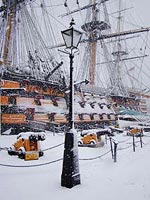 HMS Victory in recent snowy weather
HMS Victory in recent snowy weather
Portsmouth Historic Dockyard marks 88 years of HMS Victory
From broadside battles off the Mediterranean coast to Vice Admiral Lord Nelson’s triumph in the Battle of Trafalgar and campaigns in the Baltic, the guardians of HMS Victory have had plenty of reasons to celebrate since the iconic naval juggernaut first set sail in 1778.
This week the Victory’s home at Portsmouth marked 88 years since the ship moved into her final resting place in Number 2 Dock at His Majesty’s Dockyard – a position from which it still attracts 350,000 visitors every year as part of the Historic Dockyard.
Thanks to Alaric Bond for the reference.
 The US Navy is sending the rescue and salvage ship, USS Grasp, to Port-au-Prince, Haiti with divers and underwater construction personnel to assess the damage to piers and other port facilities. The USNS Comfort, a hospital ship with a capacity of a 1,000 beds, sailed from Baltimore this morning and is expected to arrive in Haiti by Thursday. The USS Bataan, an amphibious assault ship with a 800 bed hospital, sailed from Norfolk last Thursday.
The US Navy is sending the rescue and salvage ship, USS Grasp, to Port-au-Prince, Haiti with divers and underwater construction personnel to assess the damage to piers and other port facilities. The USNS Comfort, a hospital ship with a capacity of a 1,000 beds, sailed from Baltimore this morning and is expected to arrive in Haiti by Thursday. The USS Bataan, an amphibious assault ship with a 800 bed hospital, sailed from Norfolk last Thursday.
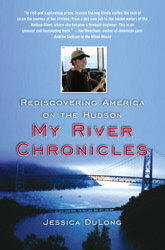 My River Chronicle – Rediscovering the America on the Hudson, is a fascinating voyage in the life of a young woman, who finds herself oddly quite at home in a most unlikely new job. It is also a journey through the history of America itself as it moves from an industrial past into an uncertain future.
My River Chronicle – Rediscovering the America on the Hudson, is a fascinating voyage in the life of a young woman, who finds herself oddly quite at home in a most unlikely new job. It is also a journey through the history of America itself as it moves from an industrial past into an uncertain future.
While working for a dot-com startup, started volunteering on a retired fire boat, the John J. Harvey. She was the first woman ever to run the engines. When her day job disappeared, she was offered a position on the fireboat where she spent so many hours as a volunteer. Over time, she became a licensed engineer on the historic fire boat, as well as the pilot on another tug.
My River Chronicle is a deft mix of DuLong’s personal memoir, mixed with the history of the mighty Hudson and the towns that line the shore, with a judicious dose of commentary thrown in for spice. The writing is graceful and engaging and she balances the various elements of her account with remarkable skill.
Continue reading
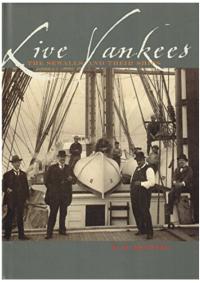 Live Yankees, the Sewalls and their Ships is a fascinating and sweeping history of one family from Bath, Maine, which built and operated over one hundred merchant ships, mostly square riggers in the 19th and early 20th centuries. It offers a complex and intriguing portrait of the shipbuilders, ship owners, captains and crews who helped drive the meteoric rise of the US sailing merchant fleet in the mid-1800s and presided over its fall in the wake of the arrival of steamships.
Live Yankees, the Sewalls and their Ships is a fascinating and sweeping history of one family from Bath, Maine, which built and operated over one hundred merchant ships, mostly square riggers in the 19th and early 20th centuries. It offers a complex and intriguing portrait of the shipbuilders, ship owners, captains and crews who helped drive the meteoric rise of the US sailing merchant fleet in the mid-1800s and presided over its fall in the wake of the arrival of steamships.
Bill Bunting accepted the daunting task of taking 315 linear feet of documents that comprise the Sewall Family Papers and translating them into a coherent and entertaining account. In the hands of a lesser writer, the book could have ended up as a dry and plodding scholarly work. Fortunately, Live Yankees is anything but. In addition to wonderful writing, the book is full of fascinating photographs of both the people and the ships described within its pages.
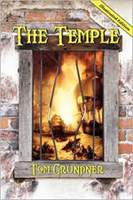 There have been hundreds of novels written about dashing Royal Navy ships’ captains who bear a striking resemblance to Lord Cochrane. The resemblance and family history are most obvious in Jack Aubrey and Horatio Hornblower, but a dozen or so other worthy fictional officers share the same heritage. It is therefore pleasing to see that Tom Grundner has tapped another naval hero from history, the intriguing and multi-faceted Sir Sidney Smith, whose colorful and often controversial naval career would span from the American Revolution through the end of the Napoleonic wars.
There have been hundreds of novels written about dashing Royal Navy ships’ captains who bear a striking resemblance to Lord Cochrane. The resemblance and family history are most obvious in Jack Aubrey and Horatio Hornblower, but a dozen or so other worthy fictional officers share the same heritage. It is therefore pleasing to see that Tom Grundner has tapped another naval hero from history, the intriguing and multi-faceted Sir Sidney Smith, whose colorful and often controversial naval career would span from the American Revolution through the end of the Napoleonic wars.
His latest novel, The Temple, begins with Sir Sidney locked in the French prison by that name. It follows his daring escape and return to England only to be dispatched the Gibraltar under the command of an admiral who despises him, a diplomatic mission to the the Ottoman court, Napoleon’s invasion of Egypt and Nelson’s victory at the Nile. The novel is sweeping in scope, fast paced and a fun read.
Continue reading
 Martin Evans on the Marine History List posted a collection of sailors’ superstitions from the current issue of “Fishing Boats”.
Martin Evans on the Marine History List posted a collection of sailors’ superstitions from the current issue of “Fishing Boats”.
Continue reading

The mega-yachts of the Russian billionaires grow ever larger, more elaborate, and, of course, ever more expensive. Roman Abramovich’s new yacht Eclipse will be the world’s largest yacht, at 557 feet (170 meters), eclipsing, so to speak, the 525-foot luxury yacht owned by Dubai ruler Sheikh Mohammed bin Rashid Al Maktoum.
Continue reading

Lars Hansen atop the Peking at the South Street Seaport in 1991.
I just read that Lars Hansen died the day before yesterday in a nursing home in Florida. He was 86. For three decades he had been the master rigger of the historic vessels of the South Street Seaport until he suffered a stroke a few years ago and had to retire.
When profiled in the New York Times two years ago, the author wrote that ”Mr. Hansen reigned for 30 years as king of the still-gritty side of the seaport. … In the collective imagination of the seaport’s salts, Mr. Hansen is a Paul Bunyan of the sea. They speak of his strength in terms like “gentle giant,” and of his kindness in phrases typically reserved for the canonization process.”
 Last May, we posted about the Tall Ship Soren Larsen’s new season of voyages – Tall ship Soren Larsen – Pearls of the Pacific, Voyages across the South Seas 2009. Unfortunately, the ship was hit by a rogue wave on the 1st of June and suffered serious damage.
Last May, we posted about the Tall Ship Soren Larsen’s new season of voyages – Tall ship Soren Larsen – Pearls of the Pacific, Voyages across the South Seas 2009. Unfortunately, the ship was hit by a rogue wave on the 1st of June and suffered serious damage.
Fortunately, no one was seriously injured, beyond a few bruises, cuts and a few strained knees. The deck house and bulwarks suffered major damage, but the ship made it safely back to port. The last few months have been spent making repairs. From the Soren Larsen site:
Continue reading

